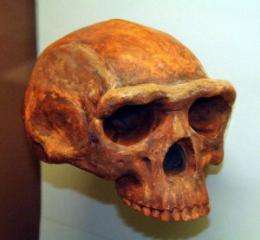Did climate change shape human evolution?

(Â鶹ÒùÔº) -- As human ancestors rose on two feet in Africa and began their migrations across the world, the climate around them got warmer, and colder, wetter and drier. The plants and animals they competed with and relied upon for food changed. Did the shifting climate play a direct role in human evolution?
The evidence so far is thin, said Richard Leakey, the renowned paleoanthropologist and conservationist who joined a score of scientists delivering their findings at a conference on climate change and human evolution this week, held at Columbia’s Lamont-Doherty Earth Observatory.
“Is there evidence for a direct connection between changing climate and human evolution?” Leakey asked during a keynote address Thursday. “The answer so far is no. I don’t see it yet.”
Still, a number of scientists are on the hunt. Speakers talked about changes in plants and animals, and how fluctuations in temperature and rainfall would have altered the landscapes. They’re studying what carbon isotopes in soil can tell us about changing plant life and temperature; what hominid teeth suggest about changes in diet; and what sediment cores from the bottom of the ocean have to say about variations in monsoon rainfall.
What did all this mean for our ancestors? If the climate affected human evolution, “there should be a substantial adaptive response,” Leakey said. But with a limited fossil record, “We are stuck with this very, very narrow vision” of human evolution, Leakey said.
Leakey has been in the middle of the search for human ancestors for decades, following in the footsteps of his famous parents, the archeologists Louis and Mary Leakey, whose work at Olduvai Gorge in northern Tanzania was key to the understanding of human evolution. He lives in Kenya, where he has been active in politics and conservation; he also is a professor of anthropology at Stony Brook University.
Leakey suggested the focus of research should be on trying to answer four key questions:
First, what would have prompted hominids to go bipedal – standing upright with the big toe pointing straight ahead?
“Standing upright on two legs is not only an odd way to be,” he said, “but a huge adaptation to what was going on.”
Second, what prompted our ancestors to begin using one tool to make another, and when: “The use of stone to make stone that can cut flesh is important. We’re not empirical things, we’re thinkers. … What was it that triggered that response?”
The third point has to do with the first migration of hominids out of Africa, when homo erectus spread into Asia and Europe. “At some point about 1.8 million years ago, a hominid shoes up in Europe. That implies experience with different environments, and that implies technology,” Leakey said. But, he asked, why didn’t that hominid continue to thrive?
Lastly, what drove the second migration of hominids — this time homo sapiens — out of Africa?
For more on the conference, . Stay tuned for a video of the talks, which will be available at the site in the future. Professor Peter deMenocal, a paleoclimatologist at Lamont-Doherty and vice chairman of the Department of Earth and Environmental Sciences, organized the conference, which brought in scientists from around the world to talk about their latest research.
Provided by Columbia University



















